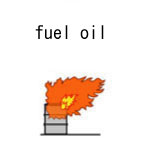| Case Name |
Fire caused due to leakage of heavy oil from vibration in the distillation section at a fuel oil direct desulfurization unit |
| Pictograph |

|
| Date |
February 18, 1996 |
| Place |
Kurashiki, Okayama, Japan |
| Location |
Refinery |
| Overview |
In the minimum flow line of the distillation column bottom pump in the fuel oil direct desulfurization unit, the drain valve opened without being noticed, and the cap came off. The bottom oil leaked, and a fire occurred. There was a problem with vibration control in the design of the minimum flow line, which was prepared for short-term use. The piping was used for a long period for the first time at the reaction system inspection. The problem of vibration control became actualized, and there was a fire. |
| Incident |
There was a fire at a fuel oil direct desulfurization unit during usual operation. Bottom oil leaked and was scattered from a 3/4-inch drain valve near a flow control valve installed on a minimum flow line of a bottom pump at a vacuum distillation column. It contacted high-temperature parts such as adjacent piping and a pump casing, ignited, and the fire spread. |
| Processing |
Manufacture |
| Individual Process |
Distillation |
| Substance |
Fuel oil |
| Type of Accident |
Leakage, fire |
| Sequence |
Two weeks before the accident, the reaction section was inspected for five days, while a recycling operation was being carried out in the distillation section. During the recycling operation, the minimum flow line with a restriction orifice was used to maintain the liquid level in each column and a reactor. This minimum flow line was originally for short-term use, and was used in the starting pump, for example. However, it continued to be used for five days. The bottom oil leaked and was scattered from the line. The oil contacted high-temperature parts such as adjacent piping and a pump casing; it ignited, and the fire spread.
Restriction orifice: an orifice inserted in piping to keep the flow rate constant. It is often installed in a recycling line so that the pump load does not become excessive. |
| Cause |
Cause of leakage: The piping system of the minimum flow line used in the recycling operation was only for short term use. Therefore, priority was given to countermeasures for thermal expansion, and there was not much support to fix the piping, and there was no consideration given to vibrations. Therefore, considerably large vibrations were generated. It seems that due to the vibrations, the drain valve and the cap gradually became loose over the five days of operation, and the drain valve finally opened, and the cap fell off. Causes of the vibrations were cavitation downstream due to the restriction orifice mounted in the minimum flow line and the restriction by the control valve.
Cause of Ignition: The leaked oil contacted hot surfaces such as adjacent piping and a pump casing, and ignition occurred. |
| Response |
Just after the accident, an emergency shutdown of this plant was carried out. Nitrogen to extinguish the fire was injected inside the vacuum distillation column. |
| Countermeasures |
Piping design considering generation of vibrations is to be carried out. Readjustment of the design review system is to be conducted. Similar places to be checked. |
| Knowledge Comment |
The problem in the piping design did not become obvious because it was not usually used. There might also have been a problem in the process of design review. If the checking process had been carried out before first use of the piping, which had not been used for long time, the accident could have been avoided. |
| Background |
The fundamental factor of the accident seems to have been bad design of the minimum flow line which generated enough vibrations to loosen the valve. Insufficient communication such as the operators did not well understand the designer's intentions and disregard of the lessons from history seem to have been problems. |
| Sequel |
Vibrations and large abnormal noises might be generated by vortexes and bubbles in a restricted flow, where the differential pressure or the pressure ratio at an inlet and an outlet is large, such as at control valves and restriction orifices. The same phenomenon had happened as wall abrasion in secondary cooling water piping at the Tsuruga nuclear power plant in 2004. |
| Reason for Adding to DB |
Example of leak caused due to improper support of piping and vibration from a throttling flow |
| Scenario |
| Primary Scenario
|
Organizational Problems, Poor Management, Slackness of Management, Poor Value Perception, Poor Safety Awareness, Inadequate Risk Recognition, Ignorance, Insufficient Knowledge, Insufficient Experience, Planning and Design, Poor Planning, Poor Design, Non-Regular Action, Inaction, No Measure against Abnormal Vibration, Bad Event, Mechanical Event, Vibration, Secondary Damage, External Damage, Fire, Loss to Organization, Economic Loss, Direct Monetary Damage 7 million yen
|
|
| Sources |
Fire and Disaster Management Agency. Fire accident caused by fuel oil leakage from fuel oil direct desulfurization unit. Accident cases of dangerous materials. 1996. pp.106-107
High Pressure Gas Safety Inst. of Japan. High pressure gas protection overview. 1997 edition - pp.198-199(1997)
National Dangerous Object Safety Association. Fire at manufacturer. Cases of accidents at dangerous facilities. -Case 100- p.5(1999)
|
| Physical Damage |
A vacuum distillation column of a fuel oil direct desulfurization unit, a pump in the vicinity and a heat exchanger were destroyed by fire. |
| Financial Cost |
¥ 7 million (Fire and Disaster Management Agency) |
| Field |
Chemicals and Plants
|
| Author |
DOBASHI, Ritsu (School of Engineering, The University of Tokyo)
TAMURA, Masamitsu (Center for Risk Management and Safety Sciences, Yokohama National University)
|
|